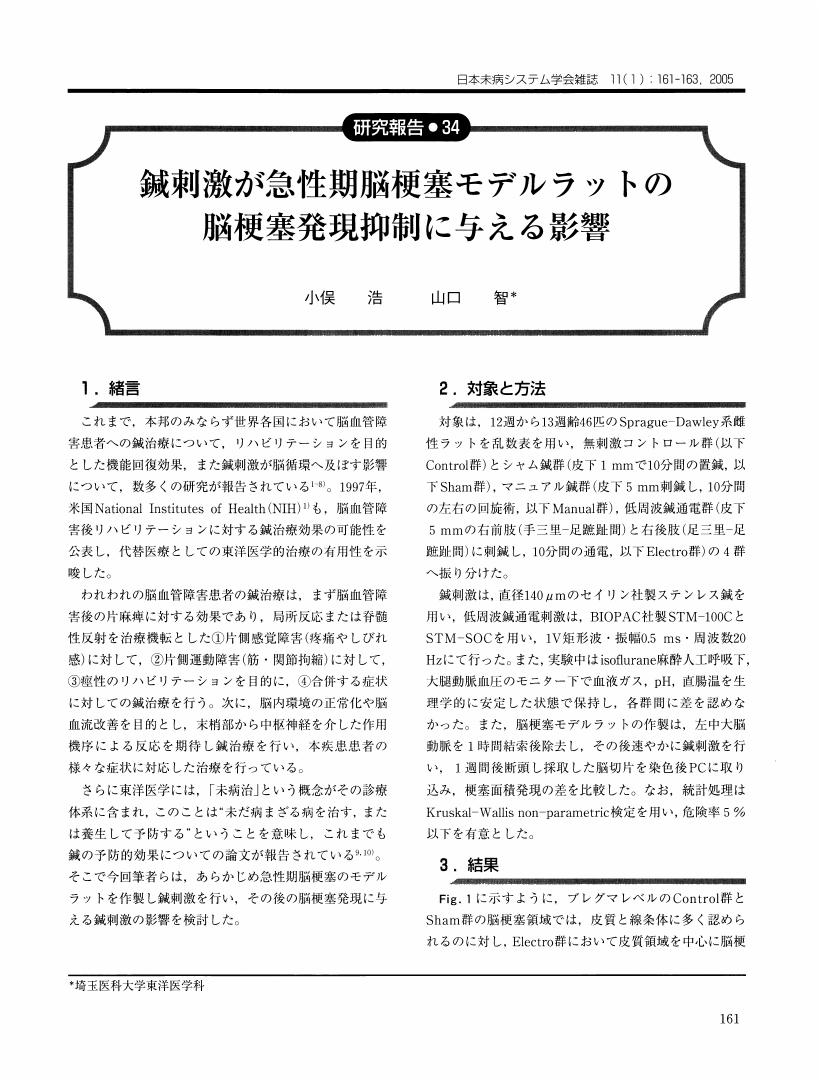3 0 0 0 OA 片頭痛発作予防に対する鍼治療効果
- 著者
- 山口 智 菊池 友和 小俣 浩 鈴木 真理 磯部 秀之
- 出版者
- 一般社団法人 日本温泉気候物理医学会
- 雑誌
- 日本温泉気候物理医学会雑誌 (ISSN:00290343)
- 巻号頁・発行日
- vol.76, no.3, pp.200-206, 2013-05-29 (Released:2013-10-18)
- 参考文献数
- 10
目的 : 片頭痛の発作予防に対する鍼治療効果を頭痛日数と頸肩部の筋群および咀嚼筋の圧痛や筋緊張を指標に分析し、その関連性について検討した。方法 : 対象は国際頭痛分類第II版の片頭痛の診断基準を満たした70例(男性22例、女性48例)平均年齢35.5歳±14.3歳(mean±S.D.)、また前兆のある片頭痛13例、前兆のない片頭痛57例である。 鍼治療を2ヶ月間行い、中等度以上の頭痛日数と頸肩部の筋群および咀嚼筋の圧痛や筋緊張を鍼治療前後で比較した。また頭痛日数の減少と圧痛および筋緊張の改善の関連性についても分析した。結果 : 鍼治療により、中等度以上の頭痛日数は減少し(p<0.05)圧痛や筋緊張も改善した(p<0.01)。また、頭痛日数の減少と頸部圧痛·肩部圧痛·咀嚼筋部圧痛の改善に正の相関が示され、頸部の関連が最も強かった。考察及び結語 : 鍼治療を一定期間継続することにより、頭痛日数が減少するとともに、頸肩部の筋群と咀嚼筋の圧痛や緊張が改善したことから、片頭痛に対する鍼治療効果はこうした筋群の圧痛を緩和することで頭痛日数が減少し、発作予防に寄与したものと考える。また、片頭痛の発作予防に対する鍼治療の作用機序は、上位頸神経や三叉神経を求心路とし、三叉神経脊髄路核を経て高位中枢に影響を及ぼし、発作予防に関与している可能性も考えられる。
3 0 0 0 OA VDT作業者に対する鍼治療効果(2)
- 著者
- 菊池 友和 山口 智 五十嵐 久佳 小俣 浩 鈴木 真理 田中 晃一 磯部 秀之 三村 俊英
- 出版者
- 社団法人 全日本鍼灸学会
- 雑誌
- 全日本鍼灸学会雑誌 (ISSN:02859955)
- 巻号頁・発行日
- vol.61, no.1, pp.51-58, 2011 (Released:2011-06-27)
- 参考文献数
- 19
- 被引用文献数
- 3
【はじめに】本邦でVDT作業者のQOLや作業能力を指標とした鍼治療に関する報告は極めて少ない。 そこで、 この前向き研究では鍼治療がVDT作業者のQOLと作業能力に及ぼす影響について検討した。 【方法】VDT作業者61例、 男性41例、 女性20例である。 鍼治療は1回/週、 個々の頸や肩の症状に応じて行った。 評価はSF-36とWAIを、 初診時と1ヵ月後の値を統計学的に検討した。 【結果】VDT作業者のSF-36は、 身体的健康度、 精神的健康度、 体の痛み、 日常役割機能 (身体) が上昇し、 活力も上昇する傾向が認められWAIも上昇した。 治療前のSF-36の各項目とWAI値、 さらに鍼治療後における体の痛みとWAI値の改善率に正の相関関係が認められた。 【結論】鍼治療によりVDT作業者の有する頸肩こりの症状が改善するとともに、 QOLと作業能力が向上した。 今後増加が予想されるVDT作業者のQOLや作業能力の向上に対し、 鍼治療の有用性が高いことが示唆された。
3 0 0 0 OA VDT作業者に対する鍼治療効果(1)
- 著者
- 鈴木 真理 山口 智 五十嵐 久佳 小俣 浩 菊池 友和 田中 晃一 磯部 秀之 大野 修嗣 三村 俊英 君嶋 眞理子
- 出版者
- 社団法人 全日本鍼灸学会
- 雑誌
- 全日本鍼灸学会雑誌 (ISSN:02859955)
- 巻号頁・発行日
- vol.60, no.5, pp.829-836, 2010 (Released:2011-05-25)
- 参考文献数
- 19
- 被引用文献数
- 1 1
【はじめに】近年、 情報化の発達により、 VDT作業者は急増している。 VDT作業者における心身の疲労は以前から問題視されているが、 多くのVDT作業者が有する頸肩こりや眼疲労に対する鍼治療効果についての報告は数少ない。 そこでこの前向き研究では、 VDT作業者の愁訴に対する鍼治療効果について検討した。 【方法】対象はVDT作業者61例 (男性41例、 女性20例) である。 鍼治療は、 週1回、 計4回、 個々の頸や肩の症状に応じて、 円皮鍼を用いて行った。 評価は、 頸こり・肩こりと眼疲労を自己記入式で行った。 VAS値の経時的変化、 また鍼治療前と4週後のVAS値より改善率を算出し、 眼疲労と頸こり・肩こりの関連について検討した。 【結果】鍼治療により頸こり、 肩こり、 眼疲労のVASの値はともに、 初診時より徐々に減少を示した。 また、 眼疲労と頸こり・肩こりの改善率には正の相関が認められた。 【結論】VDT作業者の頸や肩のこりに対し鍼治療を行い、 頸肩こりが軽減するとともに、 眼疲労も改善することが示された。 鍼治療は産業医学の分野で有用性の高いことが示唆された。
1 0 0 0 OA シェーグレン症候群 (SjS) 患者の乾燥症状に対する鍼治療効果
- 著者
- 小俣 浩 山口 智 大野 修嗣 土肥 豊
- 出版者
- 一般社団法人 日本温泉気候物理医学会
- 雑誌
- 日本温泉気候物理医学会雑誌 (ISSN:00290343)
- 巻号頁・発行日
- vol.63, no.2, pp.79-90, 2000 (Released:2010-04-30)
- 参考文献数
- 31
The effect of acupuncture electrotherapy (AET) on siccative symptoms (dry eye, dry mouth) of patients with Sjögren's syndrome (SjS) was examined using changes in the lacrimary secretion volume, the salivary secretion volume, and the skin temperature on the face as well as the dry score.1) The control group (n=10) was subjected to 1-Hz/30-Hz AET on the face and 1-Hz AET on the posterior neck and upper scapula region. Though, the 30-Hz AET on the face resulted in a significant increase in the lacrimary secretion volume, salivary secretion voloume, and skin temperature on the face, no clear changes were observed in response to stimulus at the posterior neck and upper scapula region.2) In one group of SjS patients (n=15), 30-Hz AET on the face significant increased the lacrimary secretion volume and salivary secretion volume.3) In a second group of SjS patients (n=7), no significant difference in effects with elapsed time was observed immediately after, 30 minutes after. 1 hour after, and 2 hours after applying 30-Hz AET on the face.4) In a third groups of SjS patients (n=10), no significant difference in the cumulative effect of 30-Hz AET applied to the face was observed after the first, fifth and tenth treatments. However, the dry mouth score significantly decreased from the first treatment to the tenth treatment.The above observations indicate that the effect of AET on siccative symptoms of SjS patients occurs in the order of trigeminal nerve, facila nerves, and glosspharygeal nerve reflexes (somatic-parasympathetic nerve reflex). They also indicate that the reactivity varies according to the frequency of stimulation provided, with high-frequency stimulation being particularly effective in salivation, suggesting that acupuncture may contribute to improving the QOL of patients by mitigating the subjective siccative symptoms experienced by them.
1 0 0 0 OA 混合性結合組織病に対する人参養栄湯の有用性について
- 著者
- 田中 政彦 小俣 浩 鈴木 輝彦 大野 修嗣 土肥 豊
- 出版者
- The Japan Society for Oriental Medicine
- 雑誌
- 日本東洋医学雑誌 (ISSN:02874857)
- 巻号頁・発行日
- vol.45, no.2, pp.351-357, 1994-10-20 (Released:2010-03-12)
- 参考文献数
- 12
MCTD症例における人参養栄湯の有用性について, 特にレイノー現象 (レ現象) を中心に検討を加えた。対象はMCTD 19例, 男女比2:17, 平均年齢38歳, 平均罹病期間57.6ヵ月である。方法は人参養栄湯エキス顆粒 (医療用) 9.0gを3分服とし, 4週間の連続投与とした。試験期間はレ現象が多発する11月1日より翌年の3月30日までとした。投与前後において, レ現象を含む臨床症状, 種々の検査データを比較検討し, またサーモビュアーを用いて投与前後の皮膚温も測定した。比較検討のため関心領域を設定し, その平均値を統計処理した。レ現象改善率は, やや改善以上が74%で, 悪化例は認めなかった。サーモグラフィーでは, ほぼ全関心領域において皮膚温は上昇傾向で, 特に左第I指関心領域では有意な皮膚温の上昇が認められた (P<0.05)。
1 0 0 0 OA 関節リウマチに対する鍼灸治療の多施設ランダム化比較試験
- 著者
- 粕谷 大智 沢田 哲治 磯部 秀之 赤尾 清剛 吉川 信 高田 久実子 山口 智 小俣 浩 山本 一彦
- 出版者
- 一般社団法人 日本温泉気候物理医学会
- 雑誌
- 日本温泉気候物理医学会雑誌 (ISSN:00290343)
- 巻号頁・発行日
- vol.68, no.4, pp.193-202, 2005 (Released:2010-04-30)
- 参考文献数
- 8
- 被引用文献数
- 2
(はじめに) 我々は関節リウマチに対する鍼灸治療の有効性と有用性および安全性を、外来にて薬物療法を行っている群を対照とした多施設ランダム化比較試験により検討した。(方法) 鍼灸臨床研究において重要な endpoint (評価項目) は、1. ACRコアセット (アメリカリウマチ学会提唱の活動性指標) による改善基準と、2. RAのQOL評価法であるAIMS-2日本語版を用い、介入 (治療法) については、関節リウマチの病期別に患者の活動性や機能障害を考慮しながら局所と全身の治療を行えるように病期別治療法チャートを作成し、患者の病態に応じて統一した治療法にした。(結果)1. 症例の収集についてはA群 (薬物療法群) 80例 (女性80例、男性2例、うち2例脱落)、B群 (鍼灸治療併用群) 90例 (女性90例、男性6例、うち6例脱落) の計170例が解析の対象となった。2. ACRコアセット改善基準を満たしている症例 (改善例) は、A群80例中8例、B群90例中20例で、2×2カイ二乗検定よりP=0.04で両群間において有意差を認め、鍼灸併用群の方が有意に改善を示した。3. AIMS-2質問紙によるQ0L変化: 12ケ月時点で両群間でP=0.001と有意差を認め、鍼灸併用群の方が有意に改善を認めた。4. AIMS-2質問紙の各項目の変化: 両群間で有意に鍼灸併用群に改善を認めた項目は歩行能、手指機能、家事、社交、痛み、気分、自覚改善度であった。(結語) 今回、多施設ランダム化比較試験において鍼灸併用群で上述の項目において有意に改善を認めたことは、従来の治療に鍼灸治療を併用することで身体機能低下を予防し、血行改善や精神的安定も得られ、関節リウマチ患者のQOL向上に寄与することが示唆された。
1 0 0 0 OA 鍼通電刺激が僧帽筋血流量に及ぼす影響 —99mTc04-クリアランス法による検討—
- 著者
- 菊池 友和 瀬戸 幹人 山口 智 小俣 浩 中澤 光弘 磯部 秀之 大野 修嗣 三村 俊英 北川 秀樹 高橋 啓介
- 出版者
- 一般社団法人 日本東洋医学会
- 雑誌
- 日本東洋医学雑誌 (ISSN:02874857)
- 巻号頁・発行日
- vol.61, no.6, pp.834-839, 2010 (Released:2010-12-24)
- 参考文献数
- 20
【目的】鍼通電刺激(EA)が,ヒトの筋血流に及ぼす影響を定量的に直接法で測定した報告はない。新しく開発したクリアランス法を用いEA前中後での筋血流量の変化を測定した。【方法】健康成人ボランティア10例,男性8例,女性2例(中央値30.5歳)を対象とし,鍼長50mm,直径0.18mmのステレンス鍼で僧帽筋上の天柱穴と肩井穴へEAを行い,右を刺激側,左を非刺激側とした。さらに,EA前2分,EA中4分,EA後4分の計10分のデータを分析した。同時に血圧と心拍数も測定した。【結果】EA側の筋血流量は,刺激中増加し(p < 0.05)。また刺激中,拡張期血圧と心拍数が下降した(p < 0.05)。【考察】EAにより筋血流量が刺激側で増加し,拡張期血圧と心拍数が下降したことから,局所の筋ポンプ作用等により筋血流量が増加することが考えられた。【結語】新しい99mTc04-クリアランス法を用い評価した結果,EAは,刺激中,刺激側の筋血流量を増加させた。本法はこれまでの方法よりも簡便で精度も高いことから,今後鍼灸の臨床研究により積極的に用いられて良いと考える。
1 0 0 0 OA 故佐藤昭夫先生の研究成果から見た自律神経と鍼灸
- 著者
- 佐藤 優子 内田 さえ 野口 栄太郎 今井 賢治 小俣 浩
- 出版者
- 社団法人 全日本鍼灸学会
- 雑誌
- 全日本鍼灸学会雑誌 (ISSN:02859955)
- 巻号頁・発行日
- vol.60, no.4, pp.672-692, 2010 (Released:2011-01-20)
- 参考文献数
- 49
1 0 0 0 OA 鍼刺激が急性期脳梗塞モデルラットの脳梗塞発現抑制に与える影響
- 著者
- 小俣 浩 山口 智
- 出版者
- 日本未病システム学会
- 雑誌
- 日本未病システム学会雑誌 (ISSN:13475541)
- 巻号頁・発行日
- vol.11, no.1, pp.161-163, 2005-09-26 (Released:2010-09-09)
- 参考文献数
- 23

